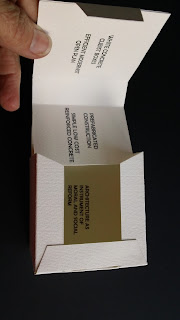My starting point for the ten books in this series has been a book structure to which I have added elements of some aspect or essence of the architect's work and this is particularly relevant with the two book sculptures Le Courbusier and Libeskind.
Around 2002 I made a couple of vellum cube books which contained divisions like chapters inside.
I liked the way they closed down to a complete white cube. This gave me the idea to use this sort of structure for Le Courbusier, as it reminded me of his white concrete box-like villas (often on stilts).
Le Courbusier was also interested in proportional theory in architecture and saw his Modulor system as a continuation of the tradition from Vitruvius, Alberti and Leonardo da Vinci. He introduced the modernist open plan and split level floors and made housing more affordable by using simple low cost reinforced concrete and prefabricated construction methods.
Using heavy 300 gsm Fabriano watercolour paper, I made a box but left the back and lid section free. The internal construction of the book has been adapted from one of Le Courbusier's internal construction plans. The pages are like two floors that overlap but create a split level, with one shorter in length than the other, like two mezzanine floors.
As the book closes, the shorter split level floor/page sits above the lower floor/page and then closes into a white cube.
Daniel Libeskind's Jewish Museum in Berlin was built in 1989-99 and I think it is one of the most remarkable pieces of architecture. It takes the shape of a zinc clad dislocated Star of David with a concealed entrance. His deconstructivist work suggests fragmentation, alienation, disorientation, oppression and is intentionally disturbing.
For this book I again made a box-like structure with angular slanted ends. I thought it appropriate to use the skin of a once-living creature - in the first version I used calfskin vellum and this time I used goatskin parchment. I cut pieces of aluminium shim to size, scored them with an embossing tool and attached them to the parchment. I cut a jagged opening in the top, slit the aluminium and rounded it under the opening.
The page of text was placed into the bottom of the box and can only be read with great difficulty, either peering through the slash in the top or lifting the bookcover-like flap at the end and peering into the narrow opening of the box.
This brings me to the end of the Ten Books on Architecture. If you have any questions about materials or techniques that I have used, please ask me. You can contact me by adding a comment or sending me an email through the contact section of my website.











8 comments:
I've really enjoyed these posts. Such inventive structures that reflect the subject matter. Thanks for sharing
It's been a wonderful, inspiring series. Your techniques are way too advanced for me but I can feel how the impressions settle inside me and they could perfectly inspire new work. I really admire your capacity to understand architecture in depth and apply its principles to the art of bookmaking.
Helen, this is such an impressive series of works. So thoroughly researched and yet not didactic. It's most inspirational and you've given me such a lot to think about. Thank-you so much for taking the time to put this series of posts together.
Thanks Jac, Ersi and Amanda for your comments. It's good to know that you have found the posts interesting and I've found it a good exercise for me to have to think about what I've done and put it into words.
The Libeskind "book" made me look more closely at the many web images of this building.Disturbing, ugly, confronting...words that most people use for this museum.And I think your book manages to suggest this, too.
Disturbing, perhaps, but powerful.
Well done, Helen.
Wow ! What an inspirational series. I've only just found it and have spent the last hour trying to come to grips with all the previous posts.Truly awesome Helen!
Hi Helen
I simply enjoy your creativity and passion.
What a complete joy you are.
I am trying to put together a blog of my work. However, That would be just one purpose, the other being a "watering hole" of creativity in which other blogs an/or links can be found of artists from all over this little rock we live on, who inspire. Would you consider having a link to your blog from mine?
Visit at:
z-micros.blogspot.com
Micros
Thanks for asking Micros, I'm happy for you to do that.
Post a Comment